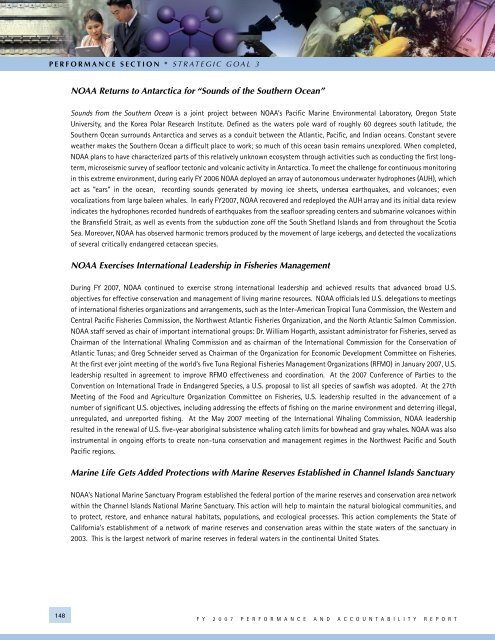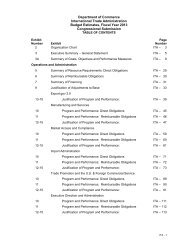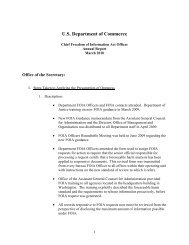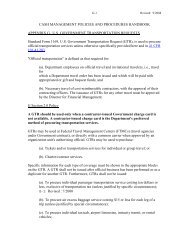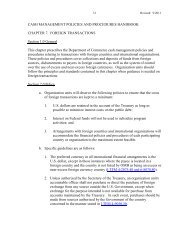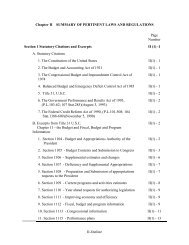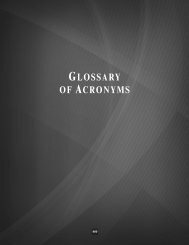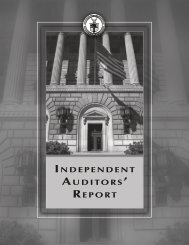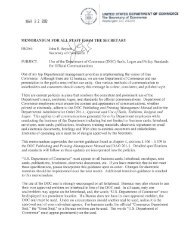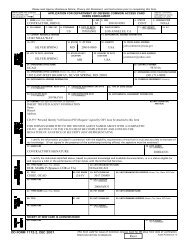United States DEPARTMENT of Commerce
United States DEPARTMENT of Commerce
United States DEPARTMENT of Commerce
You also want an ePaper? Increase the reach of your titles
YUMPU automatically turns print PDFs into web optimized ePapers that Google loves.
P e r f o r m a n c e S e c t i o n * s t r a t e g i c g o a l 3<br />
NOAA Returns to Antarctica for “Sounds <strong>of</strong> the Southern Ocean”<br />
Sounds from the Southern Ocean is a joint project between NOAA’s Pacific Marine Environmental Laboratory, Oregon State<br />
University, and the Korea Polar Research Institute. Defined as the waters pole ward <strong>of</strong> roughly 60 degrees south latitude, the<br />
Southern Ocean surrounds Antarctica and serves as a conduit between the Atlantic, Pacific, and Indian oceans. Constant severe<br />
weather makes the Southern Ocean a difficult place to work; so much <strong>of</strong> this ocean basin remains unexplored. When completed,<br />
NOAA plans to have characterized parts <strong>of</strong> this relatively unknown ecosystem through activities such as conducting the first longterm,<br />
microseismic survey <strong>of</strong> seafloor tectonic and volcanic activity in Antarctica. To meet the challenge for continuous monitoring<br />
in this extreme environment, during early FY 2006 NOAA deployed an array <strong>of</strong> autonomous underwater hydrophones (AUH), which<br />
act as “ears” in the ocean, recording sounds generated by moving ice sheets, undersea earthquakes, and volcanoes; even<br />
vocalizations from large baleen whales. In early FY2007, NOAA recovered and redeployed the AUH array and its initial data review<br />
indicates the hydrophones recorded hundreds <strong>of</strong> earthquakes from the seafloor spreading centers and submarine volcanoes within<br />
the Bransfield Strait, as well as events from the subduction zone <strong>of</strong>f the South Shetland Islands and from throughout the Scotia<br />
Sea. Moreover, NOAA has observed harmonic tremors produced by the movement <strong>of</strong> large icebergs, and detected the vocalizations<br />
<strong>of</strong> several critically endangered cetacean species.<br />
NOAA Exercises International Leadership in Fisheries Management<br />
During FY 2007, NOAA continued to exercise strong international leadership and achieved results that advanced broad U.S.<br />
objectives for effective conservation and management <strong>of</strong> living marine resources. NOAA <strong>of</strong>ficials led U.S. delegations to meetings<br />
<strong>of</strong> international fisheries organizations and arrangements, such as the Inter-American Tropical Tuna Commission, the Western and<br />
Central Pacific Fisheries Commission, the Northwest Atlantic Fisheries Organization, and the North Atlantic Salmon Commission.<br />
NOAA staff served as chair <strong>of</strong> important international groups: Dr. William Hogarth, assistant administrator for Fisheries, served as<br />
Chairman <strong>of</strong> the International Whaling Commission and as chairman <strong>of</strong> the International Commission for the Conservation <strong>of</strong><br />
Atlantic Tunas; and Greg Schneider served as Chairman <strong>of</strong> the Organization for Economic Development Committee on Fisheries.<br />
At the first ever joint meeting <strong>of</strong> the world’s five Tuna Regional Fisheries Management Organizations (RFMO) in January 2007, U.S.<br />
leadership resulted in agreement to improve RFMO effectiveness and coordination. At the 2007 Conference <strong>of</strong> Parties to the<br />
Convention on International Trade in Endangered Species, a U.S. proposal to list all species <strong>of</strong> sawfish was adopted. At the 27th<br />
Meeting <strong>of</strong> the Food and Agriculture Organization Committee on Fisheries, U.S. leadership resulted in the advancement <strong>of</strong> a<br />
number <strong>of</strong> significant U.S. objectives, including addressing the effects <strong>of</strong> fishing on the marine environment and deterring illegal,<br />
unregulated, and unreported fishing. At the May 2007 meeting <strong>of</strong> the International Whaling Commission, NOAA leadership<br />
resulted in the renewal <strong>of</strong> U.S. five-year aboriginal subsistence whaling catch limits for bowhead and gray whales. NOAA was also<br />
instrumental in ongoing efforts to create non-tuna conservation and management regimes in the Northwest Pacific and South<br />
Pacific regions.<br />
Marine Life Gets Added Protections with Marine Reserves Established in Channel Islands Sanctuary<br />
NOAA’s National Marine Sanctuary Program established the federal portion <strong>of</strong> the marine reserves and conservation area network<br />
within the Channel Islands National Marine Sanctuary. This action will help to maintain the natural biological communities, and<br />
to protect, restore, and enhance natural habitats, populations, and ecological processes. This action complements the State <strong>of</strong><br />
California’s establishment <strong>of</strong> a network <strong>of</strong> marine reserves and conservation areas within the state waters <strong>of</strong> the sanctuary in<br />
2003. This is the largest network <strong>of</strong> marine reserves in federal waters in the continental <strong>United</strong> <strong>States</strong>.<br />
148<br />
F Y 2 0 0 7 P E R F O R M A N C E A N D A C C O U N T A B I L I T Y R E P O R T


